
E-mail: aroche@ met.cmw.inf.cu; roger@ met.cmw.inf.cu
FIGURES
Abstract
1. - Introduction.
One of the forms of influence of the stratospheric aerosols SA, especially, those of volcanic origin, of exercising marked influence on the weather and the climate, it is through the feedback. Such it is the case of the chemical reactions with present compound in the stratosphere. They favor the destruction of the ozone (Brasseur, 1992), the increase of sinks of CO2 in the ocean and the terrestrial surface, as well as on the regional scale circulation (Graff et al., 1994, Handler, 1986, 1987, 1989). Precisely in this field is in which we have guided our investigation.
The atmospheric circulation is one of the essential factors in the conformation of weather and climate. In the region from Cuba in particular and of the Great Caribbean in general, it finds its synoptic representative travelers more systematical in the Tropical Cyclones (TC), the Cold Fronts (CF) and the Easterly Waves (EW). They define the main rates of rain, temperature, winds and other meteorological variables. Would it be possible to wonder Exists any stable relationship between the occurrence of the explosive volcanic eruptions EVE and the behavior of those synoptic systems, that allows to organize a strategy for the reduction of their impacts? At least in the aspects that related to the frequency of such systems, we would try to answer in the development of this paper, for which we will use several physical statistical techniques of analysis of chronological series.
2. - Methodological aspects.
They for the study of the explosive volcanic eruptions (EVE) were used those selected by Newhall and Self, 1982, cited by Handler, 1986. Such selection is based on the values of the VEI, Volcanic Explosivity Index. It is based on several aspects that could be observed or measured, during an eruption, as well as reports on the volcanic eruptions that were take play from 1860 up to 1999. They had been content in the data base BD012, generated by the project 01303012 (Aroche and Antuña 1996), which constituted a partial investigation results (Aroche et al., 1998,2000). The eruptions were divided in two groups, continuing the procedure used by Handler, 1986, according to the geographical latitude of their location. The tropical occurred inside the latitudinal band of the ±30o of latitude, and the extratropical foreign to the tropical band. We used the same criteria referred by saying author, to eliminate the possible mixing of the effects of each individual eruption.
The chronological series of the Annual Frequencies (or total of cases for season), AFTC, AFCF and AFEW, for the study of the behavior of the meteorological interest phenomena; Tropical Cyclones (TC), Cold Fronts (CF) and Easterly Waves (EW), was used. This series were elaborated in the National Forecasts Department of the National Meteorological Center of Cuba, for the periods 1986-1999, 1916-1999, 1967-1997, respectively.
The integral curves of the corrected modulated coefficients were elaborated, for the analysis of the chronological series of each meteorological phenomenon, (Aroche et al., 1999), were obtained. Their principal descriptive statistical parameters were calculated, too. By which we tried to know about the natural variability of the same.
The determination of the influence of the EVE on the frequency of the atmospheric referred atmospherical organisms; it was made starting from considering that the same should expressed through the disturbances in their chronological corresponding series. For this, in each one of the series was calculated not perturbed state and perturbed one. The first would pick up the sum of the components Tendency, Seasonality and Periodicity of the given series in itself, and the last to the disturbed component properly such (Cué et al., 1996).
For the estimate of the two referred states was employed an additive model (Cué et] al., 1996). In this model the not perturbed component was estimated considering that the same would be explained, mainly, for the same component of the representative series of the historical behavior of the energy fundamental source of the process: the sun. In order to obtain an analogy a comparative analysis of the better polinomial adjustment of both series was carried out. The solar activity was characterized by the number of Wolf (Hoyt, 1985), for the interval of years of 1875- 1981. This series was updated with the information derived of the Sunspot Index Dates Center (SIDC, 2000) from Brussels, Belgium. The annual frequency of the given phenomenon was used. The perturbed component was obtained as a difference between the original series of each phenomenon and its corresponding adjusted curve. The obtained disturbances are normalized with regard to the standard deviation of the original series.
The analysis of the series doesn't inform us directly on the causes of the behavior of the given phenomenon. The degree of association between the occurrence of the EVE and the interference in the series of the TC, CF and EW, was stimated for two different methods: that of the disturbances and that of the superposed epoch. The first locates the normalized disturbances of several magnitudes and signs temporarily and is analyzed the degree of correspondence with the moment of occurrence of the EVE. The second, it is a method frequently used on impact of EVE researches, (Sear, et al., 1987; Bradley, 1988, Aroche et al., 1999).
3. The meteorological phenomenon and vulcanological activity.
3.1 Tropical cyclones and vulcanological eruptions.
The adjusted curve of the AFTC according to the polynomial of fifth order explains of global form, the component recurrent and the tendency of the series of the TC. The analysis of Figure 1 (superior curve) permit us conjecture the existence of a general tendency to the increment of the cyclonic activity during the twenty century. At the same time, it models adequately the occurrence of the two periods of cyclonic activity decrease. One of them, situated around the decade of the ´10 and the other one, starting from that of the ´70, Aroche et al., and 2000. This allows presupposing that the occurrence of the absolute frequency extreme of 1933 is the result of a forcing for combined factors, inside which possibly this implicit an important perturbation in the own solar activity.

Figure 1: Adjusted curve of the AFTC according to the polynomial of fifth order. Anomalies (inferior curve)
In the same figure 1 (inferior curve), the results of the subtraction of the polinomial values, is sampled. That is to say the interference of the process of interest. (In which this subtraction has contrary sign).
In the sense of checking the representativity of different processes curves, it is relevant point out that, one test for independent samples was applied. It showed the existence of statistical significant differences, so much in the averages like in the variances of both series. In order to facilitate the analysis, the years were determined, for which differences were in several intervals of values (see Table 1).
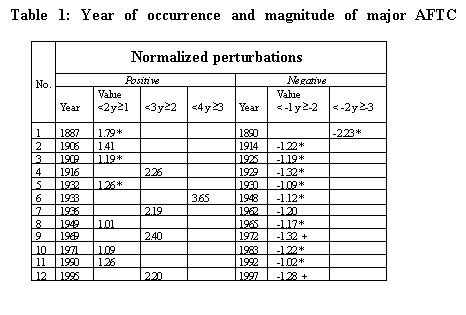
Those interference that have occurred in the same year (or to the maximum two years, hind to any of the EVE) are marked with asterisk (*) in Table 1, Aroche et al, 2000. Any EVE, that is not found in such paper, but that could have influence, not reflected through the VEI index, with (+) are marked too. With the help of which we inferred their possible relationship. Starting from this could know that the 75% of the negative interference could be explained for the occurrence of EVE, however only the 25% they of the positive seem to be associates with them. The sample formed by the interference, which have been generated for this eruptions, up to four years after their occurrence, with all they generated in the series for several factors, were compared. Significant difference was only obtained for them generated one year after them.
It is of noting in the Figure 2 that, the EVE of the tropical zone generates an important and stable descent in the frequency of the TC during about 2 or 3 posterior years to the eruption. Descent much old that the occasioned by the extratropical EVE, whose variable effects, also, are in opposite phase with regard to those of the tropical eruptions. Everything which, it could be sign of the difference of the mechanisms, through which, the same rebound on the climatic system.
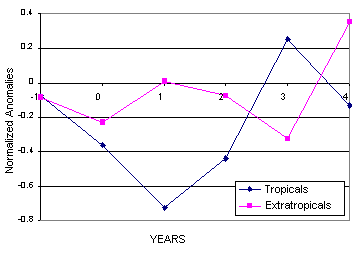
Figure 2: Variation AFTC associated with tropical and extratropical EVE occurence. According to superposed epoch method.
The produced changes, particularly, those starting from the 2.5 years after EVE, could be consider as results of the interferences of both types of eruptions. They are translated in a weakening of the final effects, which consequently, which move around the reestablishment of the normality in the behavior of the frequency of occurrence of the TC.
Nevertheless have obtained significant differences between the anomalies in the frequency of occurrence of TC, which have been determinate by superposed epoch, and all those generated by several factors according to of application of the test for independent samples, at least for a year after occurrence of the eruptions. The sign of the effects of such EVE, taking into account the semester of the year in which they occurred, was specified. The anomalies of AFTC of the season of the year of the eruption and that of subsequent year to the same were defined too. Was derived that 100% from the cases from EVE that occurred in the first semester, in the tropical band of both hemispheres, generated negative anomalies of the frequencies of the TC, in the cyclonic season of the same year and of similar manner happened with 6 of the second semester. Only that made it in the season of the following year, in the research region, with a contribution to its increase in the cyclonic activity of the season underway. So that, the volcanic eruptions that have taken place in said semester reduces the global impact what explains the fact that in the analysis of the previous epigraph the old impact has taken place in the year 1and not in the year 0.
When we carried out the analysis with regard to the EVE of the extratropical zone, the opposite was obtained. Although with less stability in the relationship, because the 66% of the eruptions of the first semester, they generated positive anomalies in the behavior of the TC, turning out to be indifferent when they are it of the second. With what it decreases the impact to the 62.5%. What expressed with a weaker impact of this type of eruptions with regard to the tropical how are accustomed to appreciate in the Figure 5.
What is discussed previously, it allow us to infer that in a study where were not separated the EVE, according to the latitude, the prevalence to the reduction of the frequency of the TC would be weakened. On the other hand, if don't keep in mind the semester of the year of EVE occurrence, would muffle the response in the formation of TC, in some cases, or it would amplify the negatives or positive in another.
3.2 Cold Fronts and volcanic eruptions.
Although in the Figure 3 is not observed the same degree of analogy between the curves of each graph, like her obtained for the TC we considered that the same exists, only limited for the minor longitude of the series of the CF. So that in the central interval of the series of CF, less affected for the implicit aliasing in the carried out procedure, is many more easy to observe. In this case it is conjectured an counterphase moving in the curves, of the order of 10 or 11 years, in the occurrence of their extreme values. If this regularity is being extrapolated, it would suggest that the beginning of the series of AFCF should be representative of a real minimal value and not a result of the sampling. It upon demanding a slight displacement of the adjusted curve downward, it would lead to the obtaining of relevant positive interferences during the period 1920-1930. This positive interference could be very well explained, keeping in mind the occurrence of the event ENSO, of great intensity of the 1925 to the 1926, whose effect of increment of the front activity is recognized (Portman and Gutzler, 1994, Cárdenas P and Naranjo L, 1999).
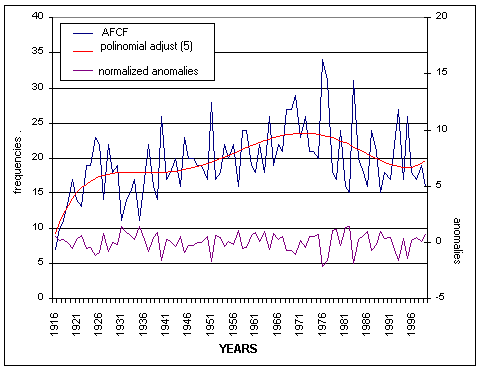
Figure 3: Adjusted curve of the AFCF according to the polynomial of fifth order. Anomalies.
The differences between the original data and the fittings of the series of CF (superior curves of the Figure 3), they will be considered as disturbances, and they will be treated of linking with forcing factors of the climate, and in particular case, with the EVE. Of similar way to describe for the TC, significant difference between the representative values of the perturbed and not perturbed states was obtained. In order to facilitate the analysis, the years were determined, for which happiness differences were in several intervals of values (see Table 2).
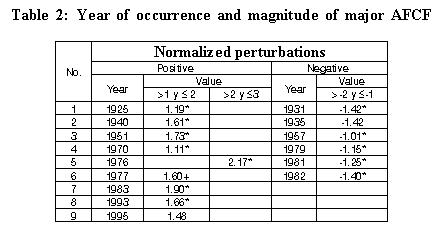
Starting from the information of the Table 2 one could determine that the 89% of the positive interferences and the 83% of the negatives are associated with the occurrence of EVE. Seemingly influencing of similar way so much in the generation of positive anomalies like negative. However it could be distinguished that the 66% of the positive is generated by EVE tropical. The same magnitude is explained in the negatives for the extratropical ones, which influence significantly and in particular in the same year of their occurrence.
In Figure 4 are shown the results of the application of the method of the superposed epoch]. In the same is of noting that the EVE of the tropical zone generates an important ascent in the frequency of the CF. It has place, particularly, during the same year of the eruption, when they cause the greater anomaly, which is during about 3 or 4 posterior years to the same, although of more and more weak way. However the extratropical ones, present a quick tendency toward positive values of the anomalies, but from a deep negative anomaly, generated in the same year of the eruption. It shows a sustained ascent, of general form, until the end of the period of analysis, whose effects are in opposite phase with regard to those of the tropical eruptions, but being, in a combined neutralized impact, or lightly negative, in the year of occurrence of the eruptions.
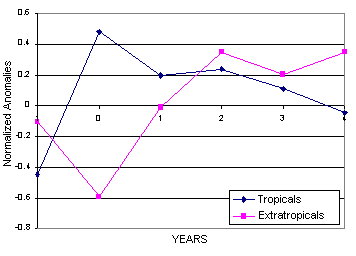
Figure 4: Variation AFCF associated with tropical and extratropical EVE occurence. According to superposed epoch method.
3.3 The Easterly Waves and volcanic eruptions.
About the evolution of the original series and the adjusted (superior curves), as well as on the interferences (inferior curve), of the process of interest, is illustrated in the Figure5. The first show a good correspondence, with a reflection of certain periodicity (Aroche et al., 2000). The third curve reflects the existence of very low interferences, which they have been normalized with regard to the standard deviation of this series. In order to facilitate the analysis, the years were determined, for which happiness differences have place in several intervals of values (see Table 3).
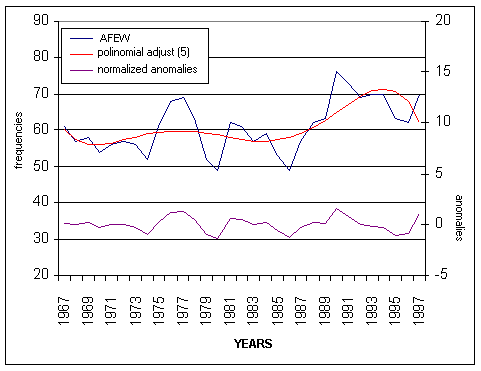
Figure 5: Adjusted curve of the AFEW according to the polynomial of fifth order. Anomalies (inferior curve)
In the Figure 6 are shown the results of the application of the method of the superposed epoch. It is of noticing that in spite of leaving of different conditions, as for values of the anomalies refer, the EVE of the tropical zone generates an important and stable descent in the frequency of the EW, particularly during about 2 or 3 posterior years to the eruption. While to the beginning (year of occurrence and hind to it) they sustain a previous positive anomaly to the event. However the extratropical EVE, in spite of sustaining the same previous to the event negative anomaly, tend to increase to the positive values, in opposite phase with the tropical EVE.
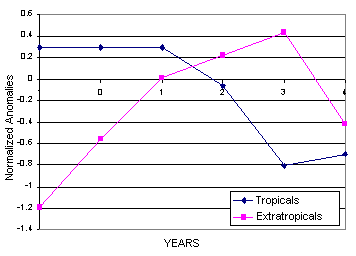
Figure 6: Variation AFEW associated with tropical and extratropical EVE occurence. According to superposed epoch method
In Table 3, we can see that the interferences don't reach the value corresponding to two standard deviations, and according to shown in the Figure 6, the normalized anomalies are predominantly negative, without overcoming 1.5 units. For these previously indicated reason it is reasonable conclude that this phenomenon is not very sensitive to the occurrence or not of EVE, but with a preferential response to diminish his annual frequency during their occurrence.
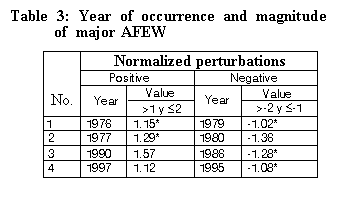
The absence of explanation of some anomalies, in the behavior of anyone of the studied meteorological systems, can be associated with the influence of other forcing factors of the climate. As good it can be the ENSO events, the variations of the solar activity, or the phase of the prevailing Quasibiennial Oscillation (QBO), during the influence of the stratospheric aerosols, originated by the EVE. Those aerosols seem to have a greater weight in the generation of the disturbances in the series of AFCF, since the meaning analysis of the differences between the alterations generated by the eruptions and the own of the original series threw negative results. It confirms upon taking into account some of these factors, as it is the sun, in the method of the disturbances as was referred previously.
4. Conclusions.
From it described in the previous epigraphs could synthesize the following: The combination of conventional statistical techniques, with the method of the integral curves of the corrected modulated coefficients, all them applied to long chronological series of geophysical variables (variables that characterize the vulcanological and solar activity and the meteorological), it allowed to determine the main characteristic of the same, between which they stand out the existence of regular periods of old or minor activity, during which the annual frequency of the TC, CF, EW and the occurrence of volcanic eruptions, they have specific relationships. The hypothesis that there is a similar behavior between the resultant of the tendency and the periodicity of the annual frecuence of the meteorological phenomenon in study, and the solar activity, was proven. Particularly for the TC and the CF, upon allowing to determine the perturbed component, by means of the application of a additive model of chronological series, that showed the existence of statistical significant differences between the two fundamental states of the series (perturbed and not perturbed). The results of the application of two different methods (that of the disturbances and that of the superposed epoch), they threw a stable relationship, between the annual frequency of the TC, the CF and the EW and that of the EVE. The most relevant aspects of such relationship, they could summarize as continues.
The EVE diminishes significantly the annual frequency of the three studied phenomenon, particularly, those that occur in the tropical zone. , With regard to the TC one year after the eruption. In the extratropical zone, with regard to the FF in the same year of occurrence, and in both types, with regard to the EW, immediately to the EVE of being extratropical or of two to three years if it is tropical. From way not significant the EVE of a given latitudinal band increases the frequency of that meteorological phenomenon whose genesis takes place in the opposite band. In the tropical band of both hemispheres, the 100% of the EVE that occurred during the first semester of the year generated negative changes in the slope of the curve of frequency of TC, in the cyclones season of the same year. When the EVE took place in the second semester, the 100% of them decrease in the season of the following year. This last contributes to the increment of the TC in the average season. The 66% of the EVE of the extratropical zone of the first semester generated positive changes in the frequency of TC of the same year. Those that occurred in the second semester made of indifferent way. The absence of explanation of some anomalies could be associate with the influence of other forcing factors of the climate. They well could be the ENSO phenomenon, the sun, or the phase of the predominant QBO lasts you the influence of the SA originated for the EVE or for the interdependence of the meteorological studied phenomenon.
5. References.
Aroche R y Antuña J. C. , 1996: Monitoreo de Aerosoles estratosféricos con lidar en la región del .Gran Caribe. Evaluación de sus repercusiones medioambientales. Nueva versión de proyecto., Proyecto 01303012. Programa Nacional de Cambios Globales. 26 pp. Inédito.
Aroche R, I. Pomares, A. Arriba, R. Estevan, J. C. Antuña, E. Martínez, S. Cervantes, 1998: Base de datos georeferenciados para la estimación de las repercuciones medioambientales de los aerosoles estratosféricos. Informe científico ? técnico. Programa Nacional de Cambios Globales. 21 pp.
Aroche R., I. Pomares, R. Estevan, B. Barja, J.C. Antuña, E. Martínez, A. Arriba, 1999: Anomalía de las condiciones atmosféricas bajo la influencia de aerosoles estratosféricos. Informe científico ? técnico. Programa Nacional de Cambios Globales. 55 pp.
Aroche R., B. Barja , I. Pomares, R. Estevan, , y González A, 2000: Repercusiones de las erupciones volcánicas sobre las condiciones meteorológicas del Gran Caribe. Informe científico ? técnico. Programa Nacional de Cambios Globales. 32 pp.
Bradley, R. S., 1988: The explosive volcanic eruption signal in Northern Hemisphere continental temperature records. Climatic Change, 12, 221 ? 243.
Brasseur G. and C. Granier, 1992: Mount Pinatubo aerosols, chlorofluorocarbons, and ozone depletion. Science, 257, 1239-1242.
Cárdenas, P. P., L. Naranjo, 1999: Impacto y modulación de efectos del ENOS sobre elementos climáticos en Cuba. UDICT, INSMET, CITMA. 14 pp.
Cué J. M., E. Castell, J. M. Hernández, 1987: Estadistica. Universidad de la Habana Ed. 398p.
Graff, H.F., J. Perlwitz, I. Kirchner, 1994: Northern Hemisphere troposphere midlatitude circulation after violent volcanic eruption. Contr. Atmos. Phys., 67, 3-13.
Handler, P., 1986: Possible association between the climatic effects of stratospheric aerosols and sea temperature in the eastern tropical Pacific Ocean. J of Clim., 6, 31-41pp.
Handler, P.,1987: Simultaneity of response of tropical cyclon in the Atlantic Ocean and Indian Monsons to reduced solar radiation from volcanic aerosols. J of Geophys. Res., 92, 14621-14630.
Handler, P., 1989: The effect of volcanic aerosols on global climate. J. of Volc. and Geoth. Res. 37, 233- 249.
Handler, P. and B. O´neill 1990: Volcanic Aerosol, El Niño event, Indian monsoons, Tropical Cyclones and corn yields. Proceeding of Biometeorological Congress. 152 ? 155.
Hoyt, D. V., 1985: Solar Records: The wolf sunspot index and umbral/penumbral ratio. CDIC Numeric Data collection. NDP ? 014. 96 pp.
Newhall C.G. y S. Self, 1982: The Volcanic Explosivity Index (VEI): An estimate of explosivity magnitude for historical vulcanism. J Geophys Res., 87, 1231 1238.
Portman, D. A., and D. S. Gutzler, 1994: Explosive volcanic Eruption, theEl Niño ? Southern Oscillation, and U. S. Climate varibility. AMS Climate. 9, 17 ? 33.
Sear, C. B., P. M. Kelly, P. D. Jones and C. M. Goodess, 1987: Global surface ? temperature responses to major volcanic eruptions. Nature, 330, 365 ? 367.
SIDC, 2000: Sunspot Index Data Center. http://www.oma.be/KSB-ORB/SIDC/index.html
Volcano, 2000. http://volcano.und.nodak.edu/vwdocs/eruption_scale.html
Back to
| Session 1 : Stratospheric Processes and their Role in Climate | Session 2 : Stratospheric Indicators of Climate Change |
| Session 3 : Modelling and Diagnosis of Stratospheric Effects on Climate | Session 4 : UV Observations and Modelling |
| AuthorData | |
| Home Page | |